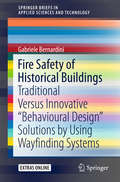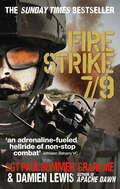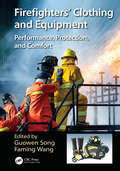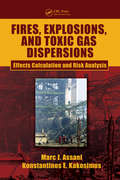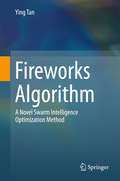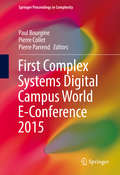- Table View
- List View
Fire Safety Engineering Design of Structures
by John A. Purkiss Long-Yuan LiDesigning structures to withstand the effects of fire is challenging, and requires a series of complex design decisions. This third edition of Fire Safety Engineering Design of Structures provides practising fire safety engineers with the tools to design structures to withstand fires. This text details standard industry design decisions, and offers
Fire Safety for Very Tall Buildings: Engineering Guide (The Society of Fire Protection Engineers Series)
by International Code CouncilThis Guide provides information on special topics that affect the fire safety performance of very tall buildings, their occupants and first responders during a fire. This Guide addresses these topics as part of the overall building design process using performance-based fire protection engineering concepts as described in the SFPE Engineering Guide to Performance Based Fire Protection. This Guide is not intended to be a recommended practice or a document that is suitable for adoption as a code. The Guide pertains to “super tall,” “very tall” and “tall” buildings. Throughout this Guide, all such buildings are called “very tall buildings.” These buildings are characterized by heights that impose fire protection challenges; they require special attention beyond the protection features typically provided by traditional fire protection methods. This Guide does not establish a definition of buildings that fall within the scope of this document.
Fire Safety in Buildings: Questions and Answers
by Pat PerryFire Safety in Buildings: Questions and Answers is a concise practical handbook on fire safety legislation, duties and requirements, providing answers to common questions relating to a range of fire prevention, protection and management issues. For each topic area the book explains a range of key terms, gives answers frequently asked questions, and presents key legislative requirements and practical guidance for ensuring compliance. Chapters also include references to further sources of information, including relevant standards and guidance documents. Coverage in the book includes: a summary of fire safety legislation and enforcement, including changes introduced in the Fire Safety Act and Building Safety Act concise practical guidance on fire safety duties, including roles of CDM dutyholders key steps in fire risk assessment fire safety protection and management for a range of different types of building a practical approach to compliance with checklists, template forms, case studies and top tips. Fire Safety in Buildings: Questions and Answers is an essential practical reference suitable for a broad range of professionals who require a concise guide to fire safety legislation, including engineers, architects, project managers, site managers, company directors, and health and safety professionals.
Fire Safety in Residential Property: A Practical Approach for Environmental Health (Routledge Focus on Environmental Health)
by Richard LordThis book aims to take the reader through all aspects of fire safety and management in residential settings, from origin and ignition, risk assessment, protection and prevention, as well as comparing effective enforcement options from across all parts of the UK. It outlines the basis of law, standards and guidance relating to fire safety and building performance, and critically evaluates the legal provisions and approaches to risk reduction with the focus on rented properties. This book: Provides wider access to fire safety knowledge previously generally used by regulators and specialists. Examines fire risk assessments in domestic premises and the competency of assessors. Explains the approaches to fire safety enforcement the impact of property licensing. Includes fire risk precautions for housing and general checklists to help landlords and tenants understand their responsibilities Explores the effect of existing legislation with references to key Property Tribunal decisions relating to fire risk management and future legal developments. This book will assist Environmental Health Officers and Environmental Health Practitioners – as well as graduating academics of the field – in their work to encourage the appropriate and effective use of legislation. Landlords, Estate managers, student accommodation managers, surveyors and tenant groups may also find this book of interest.
Fire Safety in Residential Property: A Practical Approach for Environmental Health (Routledge Focus on Environmental Health)
by Richard LordThis book aims to take the reader through all aspects of fire safety and management in residential settings, from origin and ignition, risk assessment, protection and prevention, as well as comparing effective enforcement options from across all parts of the UK. It outlines the basis of law, standards and guidance relating to fire safety and building performance, and critically evaluates the legal provisions and approaches to risk reduction with the focus on rented properties. This book: Provides wider access to fire safety knowledge previously generally used by regulators and specialists. Examines fire risk assessments in domestic premises and the competency of assessors. Explains the approaches to fire safety enforcement the impact of property licensing. Includes fire risk precautions for housing and general checklists to help landlords and tenants understand their responsibilities Explores the effect of existing legislation with references to key Property Tribunal decisions relating to fire risk management and future legal developments. This book will assist Environmental Health Officers and Environmental Health Practitioners – as well as graduating academics of the field – in their work to encourage the appropriate and effective use of legislation. Landlords, Estate managers, student accommodation managers, surveyors and tenant groups may also find this book of interest.
Fire Safety Law: A Practical Guide for Leaseholders, Building-Owners and Conveyancers
by V. Charles WardFire Safety Law provides building-owners, managers, individual leaseholders, mortgage-lenders, landlords, and anyone involved in the purchase or sale of a flat situated within a multi-occupied block, with practical, yet comprehensive and well-researched information regarding the subject of fire safety and the associated responsibilities, obligations and rights. V. Charles Ward addresses in practical legal terms the responsibilities on building-owners to ensure that buildings are fire-safe for people who are living, working, or visiting those buildings and explains what protections are available to leaseholders faced with the costs of making their buildings fire-safe. The book begins with a summary of the lessons which have come from the Grenfell Inquiry, before providing a practical overview of current fire-safety legislation relating to residential and commercial buildings. This legislative overview will include not only the 2005 Fire Safety Order, as updated by the 2021 Fire Safety Act and the Fire Safety (England) Regulations 2022, but will also include associated and emerging legislation and official guidance in relation to fire safety, including gas and electrical safety regulation, as well as the Building Safety Act 2022. The book will then pull apart a typical long-residential lease within a high-rise block to identify who is directly responsible for fire safety and explain how the costs of making good the fire-risk from defective cladding might be shared out between the ground-landlord and individual residential leaseholders. Having assessed the legal situation as regards existing high-rise leaseholders, the book then addresses the additional ‘due diligence’ required by prospective purchasers of individual high-rise flats, as well as estate agents, mortgage lenders, landlords and conveyancing lawyers, to ensure that what they will be buying or lending money on is ‘fire-safe’ and that any associated costs are fully accounted for.
Fire Safety Law: A Practical Guide for Leaseholders, Building-Owners and Conveyancers
by V. Charles WardFire Safety Law provides building-owners, managers, individual leaseholders, mortgage-lenders, landlords, and anyone involved in the purchase or sale of a flat situated within a multi-occupied block, with practical, yet comprehensive and well-researched information regarding the subject of fire safety and the associated responsibilities, obligations and rights. V. Charles Ward addresses in practical legal terms the responsibilities on building-owners to ensure that buildings are fire-safe for people who are living, working, or visiting those buildings and explains what protections are available to leaseholders faced with the costs of making their buildings fire-safe. The book begins with a summary of the lessons which have come from the Grenfell Inquiry, before providing a practical overview of current fire-safety legislation relating to residential and commercial buildings. This legislative overview will include not only the 2005 Fire Safety Order, as updated by the 2021 Fire Safety Act and the Fire Safety (England) Regulations 2022, but will also include associated and emerging legislation and official guidance in relation to fire safety, including gas and electrical safety regulation, as well as the Building Safety Act 2022. The book will then pull apart a typical long-residential lease within a high-rise block to identify who is directly responsible for fire safety and explain how the costs of making good the fire-risk from defective cladding might be shared out between the ground-landlord and individual residential leaseholders. Having assessed the legal situation as regards existing high-rise leaseholders, the book then addresses the additional ‘due diligence’ required by prospective purchasers of individual high-rise flats, as well as estate agents, mortgage lenders, landlords and conveyancing lawyers, to ensure that what they will be buying or lending money on is ‘fire-safe’ and that any associated costs are fully accounted for.
Fire Safety Management Handbook
by Daniel E. Della-GiustinaSafety managers today are required to go beyond compliance with the latest fire codes to implement proactive fire safety management programs that improve profitability. By reducing property loss insurance premiums and fostering an efficient work environment to help realize quality gains, safety managers can add to the bottom line; however, they nee
Fire Safety of Historical Buildings: Traditional Versus Innovative “Behavioural Design” Solutions by Using Wayfinding Systems (SpringerBriefs in Applied Sciences and Technology)
by Gabriele BernardiniThis book applies a behavioral point of view to individuals’ fire safety in historic buildings. It outlines theoretical and operative issues, based on recent studies and international guidelines.Firstly, critical issues for Building Heritage fire safety are widely discussed, by including the modelling of human factor and man-environment-fire interference in these architectural spaces. A significant part of the book includes a discussion on emergency modeling and simulation. A source code for representing the fire evacuation process (including man-evacuation facilities interactions) is offered to the reader.Methods for effectiveness assessment of risk-reducing solutions are provided and tested in a case-study. Being a structured approach to occupants-related problems during a fire in heritage buildings, it offers an innovative methodology and practical examples that researchers and designers can use as a guide when proposing and testing solutions. Evaluation indexes for effectiveness assessment (also useful for future guidelines or handbooks) are included. Readers are encouraged to understand these indexes within the proposed approach, so as to extend their applications and possibilities of how to introduce human behaviors-based solutions in other fields. Lastly, attention is focused on the proposal and evaluation of low-impact and not-invasive strategies, such as ones based on wayfinding elements. From this point of view, the pros and cons of wayfinding systems are discussed: these are important today, especially for fire-safety designers, because of the ongoing innovations in this field.
Fire Safety Science
by G. Cox B. LangfordThis book provides an essential reference on the current state of the art in this field covering topics as diverse as physics, chemistry, toxicology and human behaviour. It contains nearly one hundred scientific papers on all aspects of the subject. Many papers are included which illustrate the current state of development in the mathematical modelling of fire phenomena using computing.
Fire Safety Science
by Geoffrey Cox Brian LangfordThis book provides an essential reference on the current state of the art in this field covering topics as diverse as physics, chemistry, toxicology and human behaviour. It contains nearly one hundred scientific papers on all aspects of the subject. Many papers are included which illustrate the current state of development in the mathematical modelling of fire phenomena using computing.
Fire Science: From Chemistry to Landscape Management (Springer Textbooks in Earth Sciences, Geography and Environment)
by Francisco Castro Rego Penelope Morgan Paulo Fernandes Chad HoffmanThis textbook provides students and academics with a conceptual understanding of fire behavior and fire effects on people and ecosystems to support effective integrated fire management. Through case studies, interactive spreadsheets programmed with equations and graphics, and clear explanations, the book provides undergraduate, graduate, and professional readers with a straightforward learning path. The authors draw from years of experience in successfully teaching fundamental concepts and applications, synthesizing cutting-edge science, and applying lessons learned from fire practitioners. We discuss fire as part of environmental and human health. Our process-based, comprehensive, and quantitative approach encompasses combustion and heat transfer, and fire effects on people, plants, soils, and animals in forest, grassland, and woodland ecosystems from around the Earth. Case studies and examples link fundamental concepts to local, landscape, and global fire implications, including social-ecological systems. Globally, fire science and integrated fire management have made major strides in the last few decades. Society faces numerous fire-related challenges, including the increasing occurrence of large fires that threaten people and property, smoke that poses a health hazard, and lengthening fire seasons worldwide. Fires are useful to suppress fires, conserve wildlife and habitat, enhance livestock grazing, manage fuels, and in ecological restoration. Understanding fire science is critical to forecasting the implication of global change for fires and their effects. Increasing the positive effects of fire (fuels reduction, enhanced habitat for many plants and animals, ecosystem services increased) while reducing the negative impacts of fires (loss of human lives, smoke and carbon emissions that threaten health, etc.) is part of making fires good servants rather than bad masters.
Fire Science and Technology 2015: The Proceedings of 10th Asia-Oceania Symposium on Fire Science and Technology
by Kazunori Harada Ken Matsuyama Keisuke Himoto Yuji Nakamura Kaoru WakatsukiThis book focuses on topics in the entire spectrum of fire safety science, targeting research in fires, explosions, combustion science, heat transfer, fluid dynamics, risk analysis, structural engineering, and other subjects. The book contributes to a gain in advanced scientific knowledge and presents or advances new ideas in all topics in fire safety science. Two decades ago, the 1st Asia-Oceania Symposium on Fire Science and Technology was held in Hefei, China. Since then, the Asia-Oceania Symposia have grown in size and quality. This book, reflecting that growth, helps readers to understand fire safety technology, design, and methodology in diverse areas including historical buildings, photovoltaic panels, batteries, and electric vehicles.
Fire Strike 7/9
by Damien Lewis Paul Grahame'Being a JTAC is the closest a soldier on the ground in the midst of battle can get to feeling like one of the gods - unleashing pure hellfire, death and destruction' - Duncan FalconerMeet Sergeant 'Bommer' Grahame, one of the deadliest soldiers on the battlefield. He's an elite army JTAC (Joint Terminal Attack Controller- pronounced 'jay-tack') - a specially trained warrior responsible for directing Allied air power with high-tech precision. Commanding Apache gunships, A10 tank-busters, F15s and Harrier jets, he brings down devastating fire strikes against the attacking Taliban, often danger close to his own side. Due to his specialist role, Sergeant Grahame usually operates in the thick of the action, where it's at its most fearsome and deadly. Conjuring the seemingly impossible from apparently hopeless situations, soldiers in battle rely on the skill and bravery of their JTAC to enable them to win through in the heat of the danger zone. Fire Strike 7/9 tells the story of Bommer Grahame and his five-man Fire Support Team on their tour of Afghanistan. Patrolling deep into enemy territory, they were hunted and targeted by the Taliban, shot at, blown-up, mortared and hit by rockets on numerous occasions. Under these conditions Sergeant Grahame notched up 203 confirmed enemy kills, making him the difference between life and death both for his own troops and the Taliban.
Firefighters' Clothing and Equipment: Performance, Protection, and Comfort
by Guowen Song Faming WangProtective clothing and equipment used for firefighters protect them against their harsh working environment loaded with strong thermal hazards, elevated environmental temperatures, low oxygen concentration and smoke. This book describes an in-depth review of firefighting clothing and equipment, and explicitly addresses the performance of protection and comfort in textile engineering, clothing design, and evaluation. Covered topics include protection and comfort requirements for firefighting clothing and equipment, testing methods, standards and performance evaluation, smart firefighting clothing for first responders and numerical modeling of performance of firefighting clothing. Key Features Presents complete overview about the requirements of firefighters' protective clothing/thermal protective materials Addresses performance of protection and comfort Includes human thermoregulation system and responses to firefighting working environment Discusses SMART firefighting clothing and equipment Suggests "how to improve the wear comfort?
Firefighters' Clothing and Equipment: Performance, Protection, and Comfort
by Guowen Song Faming WangProtective clothing and equipment used for firefighters protect them against their harsh working environment loaded with strong thermal hazards, elevated environmental temperatures, low oxygen concentration and smoke. This book describes an in-depth review of firefighting clothing and equipment, and explicitly addresses the performance of protection and comfort in textile engineering, clothing design, and evaluation. Covered topics include protection and comfort requirements for firefighting clothing and equipment, testing methods, standards and performance evaluation, smart firefighting clothing for first responders and numerical modeling of performance of firefighting clothing. Key Features Presents complete overview about the requirements of firefighters' protective clothing/thermal protective materials Addresses performance of protection and comfort Includes human thermoregulation system and responses to firefighting working environment Discusses SMART firefighting clothing and equipment Suggests "how to improve the wear comfort?
Firefighting and Fire Safety Systems on Ships
by Alexander Arnfinn OlsenThis accessible reference introduces firefighting and fire safety systems on ships and is written in line with the IACS Classification Rules for Firefighting Systems. It covers the design, construction, use and maintenance of firefighting and fire safety systems, with cross references to the American Bureau of Shipping rules and various Classification Society regulations which pertain to specific Classification Society rules. Focuses on basic principles in line with current practice Aimed at non-specialists The book suits professional seafarers, students, and cadets, as well as leisure sailors and professionals involved in the logistics industry. It is also particularly useful for naval architects, ship designers, and engineers who need to interpret the Class rules when developing shipboard firefighting systems.
Firefighting and Fire Safety Systems on Ships
by Alexander Arnfinn OlsenThis accessible reference introduces firefighting and fire safety systems on ships and is written in line with the IACS Classification Rules for Firefighting Systems. It covers the design, construction, use and maintenance of firefighting and fire safety systems, with cross references to the American Bureau of Shipping rules and various Classification Society regulations which pertain to specific Classification Society rules. Focuses on basic principles in line with current practice Aimed at non-specialists The book suits professional seafarers, students, and cadets, as well as leisure sailors and professionals involved in the logistics industry. It is also particularly useful for naval architects, ship designers, and engineers who need to interpret the Class rules when developing shipboard firefighting systems.
Fires, Explosions, and Toxic Gas Dispersions: Effects Calculation and Risk Analysis
by Marc J. Assael Konstantinos E. KakosimosToday's risk analysis is a very challenging field, and a solid understanding of the calculations procedure associated with it is essential for anyone involved. Fires, Explosions, and Toxic Gas Dispersions: Effects Calculation and Risk Analysis provides an overview of the methods used to assess the risk of fires, explosions, and toxic gas dispersion
Fires in Silos: Hazards, Prevention, and Fire Fighting
by Ulrich KrauseProviding many lessons learned from past silo fires coupled with in-depth knowledge from experts, this book explains current prevention measures in detail -- helping to prevent future damage. It covers numerous types of fire detection devices and fire fighting equipment, backed by extensive data tables listing fire and explosion characteristics of bulk materials, color photographs of silos on fire and documentation of firefighters' actions. In addition, diagrams and formulas as well as pre-prepared check lists are included for risk assessment and fire fighting actions. Possibly lifesaving reading for chemists in industry, engineers, chemical engineers, health officers, environmental consultants, instructors in the chemical industry, as well as chemicals suppliers and safety officers.
Fireworks Algorithm: A Novel Swarm Intelligence Optimization Method (Advances In Computational Intelligence And Robotics Ser.)
by Ying TanThis book is devoted to the state-of-the-art in all aspects of fireworks algorithm (FWA), with particular emphasis on the efficient improved versions of FWA. It describes the most substantial theoretical analysis including basic principle and implementation of FWA and modeling and theoretical analysis of FWA. It covers exhaustively the key recent significant research into the improvements of FWA so far. In addition, the book describes a few advanced topics in the research of FWA, including multi-objective optimization (MOO), discrete FWA (DFWA) for combinatorial optimization, and GPU-based FWA for parallel implementation. In sequels, several successful applications of FWA on non-negative matrix factorization (NMF), text clustering, pattern recognition, and seismic inversion problem, and swarm robotics, are illustrated in details, which might shed new light on more real-world applications in future. Addressing a multidisciplinary topic, it will appeal to researchers and professionals in the areas of metahuristics, swarm intelligence, evolutionary computation, complex optimization solving, etc.
First and Second Order Circuits and Equations: Technical Background and Insights
by Robert O'RourkeHelp protect your network with this important reference work on cyber security First and second order electric and electronic circuits contain energy storage elements, capacitors and inductors, fundamental to both time and frequency domain circuit response behavior, including exponential decay, overshoot, ringing, and frequency domain resonance. First and Second Order Circuits and Equations provides an insightful and detailed learning and reference resource for circuit theory and its many perspectives and duals, such as voltage and current, inductance and capacitance, and serial and parallel. Organized and presented to make each information topic immediately accessible, First and Second Order Circuits and Equations offers readers the opportunity to learn circuit theory faster and with greater understanding. First and Second Order Circuits and Equations readers will also find: Root locus charts of second order characteristic equation roots both in terms of damping factor ζ as well as damping constant α. Detailed treatment of quality factor Q and its relationship to bandwidth and damping in both frequency and time domains. Inductor and capacitor branch relationship step response insights in terms of calculus intuition. Derivations of voltage divider and current divider formulae in terms of Kirchhoff’s laws. First and Second Order Circuits and Equations is an essential tool for electronic industry professionals learning circuits on the job, as well as for electrical engineering, mechanical engineering, and physics students learning circuits and their related differential equations.
First and Second Order Circuits and Equations: Technical Background and Insights
by Robert O'RourkeHelp protect your network with this important reference work on cyber security First and second order electric and electronic circuits contain energy storage elements, capacitors and inductors, fundamental to both time and frequency domain circuit response behavior, including exponential decay, overshoot, ringing, and frequency domain resonance. First and Second Order Circuits and Equations provides an insightful and detailed learning and reference resource for circuit theory and its many perspectives and duals, such as voltage and current, inductance and capacitance, and serial and parallel. Organized and presented to make each information topic immediately accessible, First and Second Order Circuits and Equations offers readers the opportunity to learn circuit theory faster and with greater understanding. First and Second Order Circuits and Equations readers will also find: Root locus charts of second order characteristic equation roots both in terms of damping factor ζ as well as damping constant α. Detailed treatment of quality factor Q and its relationship to bandwidth and damping in both frequency and time domains. Inductor and capacitor branch relationship step response insights in terms of calculus intuition. Derivations of voltage divider and current divider formulae in terms of Kirchhoff’s laws. First and Second Order Circuits and Equations is an essential tool for electronic industry professionals learning circuits on the job, as well as for electrical engineering, mechanical engineering, and physics students learning circuits and their related differential equations.
First Class Killing: An Alex Shanahan Thriller (The\alex Shanahan Thrillers Ser. #3)
by Lynne HeitmanAlex Shanahan is tough, resourceful and beautiful - she also happens to be a private investigator for the aviation world. When Majestic Airlines gets suspicious that some of its staff are abusing its databases for a rather alarming reason, they call in Alex to find out the hard facts.Going undercover as an air-hostess, navigating the gossip and the politics, she soon discovers that a group of her female colleagues are running an 'escort' service for Majestic's customers. Dismissive at first, the closer Alex gets to the cunning and dangerous woman who is running the operation, the more she realises the violence involved. Soon she finds herself investigating murder as well as fraud . . .Book 3 in the Alex Shanahan series.
First Complex Systems Digital Campus World E-Conference 2015 (Springer Proceedings in Complexity)
by Paul Bourgine Pierre Collet Pierre ParrendThis book contains the proceedings as well as invited papers for the first annual conference of the UNESCO Unitwin Complex System Digital Campus (CSDC), which is an international initiative gathering 120 Universities on four continents, and structured in ten E-Departments. First Complex Systems Digital Campus World E-Conference 2015 features chapters from the latest research results on theoretical questions of complex systems and their experimental domains.The content contained bridges the gap between the individual and the collective within complex systems science and new integrative sciences on topics such as: genes to organisms to ecosystems, atoms to materials to products, and digital media to the Internet.The conference breaks new ground through a dedicated video-conferencing system – a concept at the heart of the international UNESCO UniTwin, embracing scientists from low-income and distant countries. This book promotes an integrated system of research, education, and training. It also aims at contributing to global development by taking into account its social, economic, and cultural dimensions.First Complex Systems Digital Campus World E-Conference 2015 will appeal to students and researchers working in the fields of complex systems, statistical physics, computational intelligence, and biological physics.






